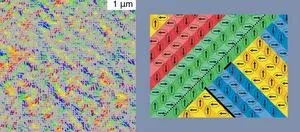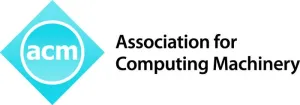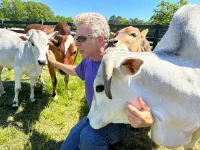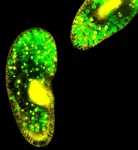(Press-News.org) HOUSTON – (August 1, 2024) – Materials behave differently in different size regimes, and researchers tend to cluster their efforts either at the nanoscale, examining materials in atom-level detail, or at the microscale, looking at structures between three and five orders of magnitude greater.
However, less is known about what happens in the “in-between” realm spanning from 10 billionths to 1 millionth of a meter.
“We call this the mesoscale,” said Rice University materials scientist Lane Martin, who together with collaborators at the U.S. Department of Energy’s (DOE) Argonne National Laboratory and Lawrence Berkeley National Laboratory, focused on this overlooked interval for insight into how a piezoelectric material transforms a voltage into a change in shape and vice versa.
“We examined a piezoelectric material called a relaxor ferroelectric and uncovered an exciting connection between the nanoscale features of its atomic structure and its macroscopic material properties,” said Martin, who is a corresponding author on a study about the research published in Science. “Our insights into the mesoscale structures provide a new approach to the design of smaller electromechanical devices that work in ways not thought possible.”
The research could inform applications in high-efficiency energy storage and conversion, next-generation electronics, lasers and sensors.
The focus of the study is an oxide made of a complex mixture of lead, magnesium, niobium and titanium, and it is characterized by tiny pairs of positive and negative charges, or dipoles, that group into clusters called polar nanodomains. Under an electric field, these dipoles align in the same direction, causing the material to change shape, or strain. Similarly, applying a strain can alter the dipole direction, creating an electric voltage.
“If you analyze a material at the nanoscale, you only learn about the average atomic structure within an ultrasmall region,” said Yue Cao, an Argonne physicist who is also a corresponding author on the study. “But materials are not necessarily uniform and do not respond in the same way to an electric field in all parts. This is where the mesoscale can paint a more complete picture bridging the nano- to microscale.”
To test the material under operating conditions, Martin, Rice’s Robert A. Welch Professor, professor of materials science and nanoengineering and director of the Rice Advanced Materials Institute, developed a fully functional relaxor device composed of a thin film (55 nanometers) of the material sandwiched between nanoscale layers that served as electrodes used to apply a voltage and generate an electric field.
Using beamlines in sectors 26-ID and 33-ID of Argonne’s Advanced Photon Source (APS), Argonne team members mapped the mesoscale structures within the relaxor. Key to success was a specialized capability called coherent X-ray nano-diffraction, available through the Hard X-ray Nanoprobe (Sector 33-ID) operated by the Center for Nanoscale Materials at Argonne and the APS. Both are DOE Office of Science-user facilities.
The results showed that under an electric field, the nanodomains self-assemble into mesoscale structures consisting of dipoles that align in a complex tilelike pattern (see image). The team identified the strain locations along the borders of this pattern and the regions responding more strongly to the electric field.
“These submicroscale structures represent a new form of nanodomain self-assembly not known previously,” noted John Mitchell, an Argonne Distinguished Fellow. “Amazingly, we could trace their origin all the way back down to underlying nanoscale atomic motions; it’s fantastic!”
“The brighter and more coherent X-ray beams now possible with the recent APS upgrade will allow us to continue to improve our device,” said Hao Zheng, the lead author of the research and now a beamline scientist at the APS. “We can then assess whether it has application for energy-efficient microelectronics such as neuromorphic computing modeled on the human brain.”
Low-power microelectronics are essential for addressing the ever-growing power demands from electronic devices around the world, including cell phones, desktop computers and supercomputers.
The research was supported by the DOE (DE-AC02-06CH11357, DE-AC02-06CH11357, DE-SC-0012375), the Army Research Laboratory (W911NF-24-2-0100), the Army Research Office (W911NF-21-1-0118) and the National Science Foundation (2329111).
Content adapted from an article by Joseph E. Harmon, Argonne National Laboratory. The content in this press release is solely the responsibility of the authors and does not necessarily represent the official views of the supporting institutions.
-30-
This news release can be found online at news.rice.edu.
Follow Rice News and Media Relations via Twitter @RiceUNews.
Peer-reviewed paper:
“Heterogeneous field response of hierarchical polar laminates in relaxor ferroelectrics” | Science | DOI: 10.1126/science.ado4494
Authors: Hao Zheng, Tao Zhou, Dina Sheyfer, Jieun Kim, Travis Frazer, Zhonghou Cai, Martin Holt, Zhan Zhang, J.F. Mitchell, Lane Martin and Yue Cao
https://www.science.org/doi/10.1126/science.ado4494
Image downloads:
https://news-network.rice.edu/news/files/2024/08/LMartin.jpg
CAPTION: Lane Martin is the Robert A. Welch Professor, professor of materials science and nanoengineering and director of the Rice Advanced Materials Institute at Rice University.(Photo by Jeff Fitlow/Rice University)
https://news-network.rice.edu/news/files/2024/08/ferroelectric.jpg
CAPTION: Vector field (left) representing the spatial distribution of projected lattice tilt in the relaxor ferroelectric material, where different orientations of the lattice tilt are labeled with different colors. Alignments of dipole directions (right) in mesoscale structures within a zoomed in region of the material. (Image courtesy of Argonne National Laboratory)
About Rice:
Located on a 300-acre forested campus in Houston, Rice University is consistently ranked among the nation’s top 20 universities by U.S. News & World Report. Rice has highly respected schools of architecture, business, continuing studies, engineering, humanities, music, natural sciences and social sciences and is home to the Baker Institute for Public Policy. With 4,574 undergraduates and 3,982 graduate students, Rice’s undergraduate student-to-faculty ratio is just under 6-to-1. Its residential college system builds close-knit communities and lifelong friendships, just one reason why Rice is ranked No. 1 for lots of race/class interaction, No. 2 for best-run colleges and No. 12 for quality of life by the Princeton Review. Rice is also rated as a best value among private universities by Kiplinger’s Personal Finance.
END
Rice, DOE labs tackle knowledge gap in materials science research
Overlooked range between the nano- and microscale holds promise for energy and other applications
2024-08-01
ELSE PRESS RELEASES FROM THIS DATE:
ACM publishes first issue of Proceedings of the ACM on Software Engineering
2024-08-01
ACM, the Association for Computing Machinery, has recently published the first issue of Proceedings of the ACM on Software Engineering (PACSME), a new Gold Open Access journal publishing top-quality, original research on all aspects of software engineering, from requirements elicitation to quality assessment, design, maintenance, evolution, and deployment. PACMSE covers a broad range of topics and methods that help conceive, create, and maintain better software be it embedded, cloud-based, mobile and ubiquitous, or runs on conventional computers.
“The overarching goal of the new PACSME journal is to make ...
Barriers complicate exercise for disability community
2024-08-01
An estimated 16% of people worldwide live with a significant disability that impacts their daily life. Of this population, only about 40% engage in aerobic activity. Due to this lack of exercise, people with disabilities (PWD) are more likely to suffer from chronic conditions such as heart disease, stroke, diabetes, or cancer and are at higher risk of mental illnesses like depression and anxiety.
“Many PWD struggle with psychological issues such as low self-esteem and negative body image, which can further reduce their motivation to participate in exercise activities, especially in public places ...
Venezuelan crisis has negatively affected country’s Internet
2024-08-01
As the Venezuelan crisis intensifies, researchers and policy experts have worked to understand its ramifications on the country’s politics, economics, health services, water security, infrastructure and more.
Now, Northwestern University computer scientists have comprehensively examined the effects of the crisis on a previously unexplored area: the Internet.
In a new study, the researchers found the crisis has significantly — and negatively — affected Venezuela’s Internet infrastructure and connectivity. Compared to the ...
COSPAR 2024: Embracing team spirit in space research
2024-08-01
The Committee on Space Research (COSPAR) has successfully concluded its 45th COSPAR Scientific Assembly in Busan, Korea, held from 13 to 21 July. This prestigious event brought together more than 3,000 experts and leaders from 55 countries in all major fields of space science, under the theme “Team Spirit in Space Research”. This biennial event, actively supported by major space organizations, is a benchmark for fostering dialogue and collaboration within the global space science community.
Bringing space leaders together
Of particular note this time was the showcasing of ...
'Cowpuppy' takes readers into secret world of cows
2024-08-01
During the height of the COVID-19 pandemic Gregory Berns, a neuroscientist at Emory University, moved from Atlanta to a farm an hour south of the city. His reinvention from city dweller to farmer led to his upcoming book “Cowpuppy: An Unexpected friendship and a Scientist’s Journey into the Secret World of Cows.”
Set for publication by Harper Collins on August 20, the book describes Berns’ crash course to becoming a cattleman and his ongoing fascination with the interior world of cows.
Berns originally bought a few cows to keep the grass in the ...
Warming stops tiny organisms working together
2024-08-01
Hotter conditions prevent two tiny organisms working together for mutual benefit, new research shows.
University of Exeter scientists studied a single-celled organism (Paramecium bursaria) which can absorb and host algae (Chlorella spp).
This pairing is common in freshwater worldwide, and their symbiotic relationship provides benefits including trading of nutrients and protection for the algae.
But when scientists made the water 5°C warmer, the partnership stopped working – and the results suggest the algae may even become parasitic.
The breakdown of such relationships could have a major impact on ecosystems.
“This ...
Gun permits may be more effective than background checks alone at reducing firearm homicides
2024-08-01
Despite widespread support, laws enforcing universal background checks at the time of firearm purchase may not be enough to move the needle on reducing shooting deaths in the United States. A Tufts University School of Medicine study, published August 1 in the journal JAMA Network Open, reports that states that require gun permits rather than relying solely on universal background checks see firearm homicide rates, on average, 18% lower than states with background check policies alone.
The analysis compared firearm homicide data from the 12 states with universal background check laws but no permit ...
Study finds regular aspirin use associated with greatest reduction in colorectal cancer among those most at risk
2024-08-01
Regular aspirin may help lower risk of colorectal cancer in people with greater lifestyle-related risk factors for the disease, according to a study led by researchers at Mass General Brigham. The study, published in JAMA Oncology, could encourage a more nuanced approach to preventive aspirin use.
“We sought to identify individuals who are more likely to benefit from aspirin to facilitate more personalized prevention strategies,” said co-senior author Andrew Chan, MD, MPH, Director of Epidemiology for the Mass General Cancer Center and gastroenterology Director of the Center for ...
Diagnostic accuracy of an integrated AI tool to estimate gestational age from blind ultrasound sweeps
2024-08-01
About The Study: Between 14 and 27 weeks’ gestation, novice users with no prior training in ultrasonography estimated gestational age as accurately with the low-cost, point-of-care artificial intelligence (AI) tool as credentialed sonographers performing standard biometry on high-specification machines. These findings have immediate implications for obstetrical care in low-resource settings, advancing the World Health Organization goal of ultrasonography estimation of gestational age for all pregnant people.
Quote from corresponding author Jeffrey ...
Aspirin use and incidence of colorectal cancer according to lifestyle risk
2024-08-01
About The Study: Aspirin use was associated with a greater absolute reduction in risk of colorectal cancer among individuals with less healthy lifestyles in this cohort study. The findings of the study suggest that lifestyle risk factors may be useful to identify individuals who may have a more favorable risk-benefit profile for cancer prevention with aspirin.
Corresponding Authors: To contact the corresponding authors, email Andrew T. Chan, MD, MPH (achan@mgh.harvard.edu) and Long H. Nguyen, MD, MS (lnguyen24@mgh.harvard.edu).
To access the embargoed study: Visit our For The Media website at this link https://media.jamanetwork.com/
(doi:10.1001/jamaoncol.2024.2503)
Editor’s ...
LAST 30 PRESS RELEASES:
NSF–DOE Vera C. Rubin Observatory spots record-breaking asteroid in pre-survey observations
Ribosomal engineering creates “super-probiotic” bacteria
This self-powered eye tracker harnesses energy from blinking and is as comfortable as everyday glasses
Adverse prenatal exposures linked to higher rates of mental health issues, brain changes in adolescents
Restoring mitochondria shows promise for treating chronic nerve pain
Nature study identifies a molecular switch that controls transitions between single-celled and multicellular forms
USU chemists' CRISPR discovery could lead to single diagnostic test for COVID, flu, RSV
Early hominins from Morocco reveal an African lineage near the root of Homo sapiens
Small chimps, big risks: What chimps show us about our own behavior
We finally know how the most common types of planets are created
Thirty-year risk of cardiovascular disease among healthy women according to clinical thresholds of lipoprotein(a)
Yoga for opioid withdrawal and autonomic regulation
Gene therapy ‘switch’ may offer non-addictive pain relief
Study shows your genes determine how fast your DNA mutates with age
Common brain parasite can infect your immune cells. Here's why that's probably OK
International experts connect infections and aging through cellular senescence
An AI–DFT integrated framework accelerates materials discovery and design
Twist to reshape, shift to transform: Bilayer structure enables multifunctional imaging
CUNY Graduate Center and its academic partners awarded more than $1M by Google.org to advance statewide AI education through the Empire AI consortium
Mount Sinai Health system receives $8.5 million NIH grant renewal to advance research on long-term outcomes in children with congenital heart disease
Researchers develop treatment for advanced prostate cancer that could eliminate severe side effects
Keck Medicine of USC names Christian Pass chief financial officer
Inflatable fabric robotic arm picks apples
MD Anderson and SOPHiA GENETICS announce strategic collaboration to accelerate AI-driven precision oncology
Oil residues can travel over 5,000 miles on ocean debris, study finds
Korea University researchers discover that cholesterol-lowering drug can overcome chemotherapy resistance in triple-negative breast cancer
Ushikuvirus: A newly discovered giant virus may offer clues to the origin of life
Boosting the cell’s own cleanup
Movement matters: Light activity led to better survival in diabetes, heart, kidney disease
Method developed to identify best treatment combinations for glioblastoma based on unique cellular targets
[Press-News.org] Rice, DOE labs tackle knowledge gap in materials science researchOverlooked range between the nano- and microscale holds promise for energy and other applications






